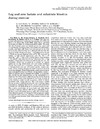Identificador persistente para citar o vincular este elemento:
https://accedacris.ulpgc.es/jspui/handle/10553/6566
| Título: | Leg and arm lactate and substrate kinetics during exercise | Autores/as: | van Hall, Gerrit Jensen-Urstad, Matts Rosdahl, Hans Holmberg, Hans-Christer Saltin, Bengt Calbet, JAL |
Clasificación UNESCO: | 241106 Fisiología del ejercicio | Palabras clave: | Lactate Exercise Muscle metabolism |
Fecha de publicación: | 2003 | Publicación seriada: | American Journal of Physiology - Endocrinology and Metabolism | Resumen: | To study the role of muscle mass and muscle activity on lactate and energy kinetics during exercise, whole body and limb lactate, glucose, and fatty acid fluxes were determined in six elite cross-country skiers during roller-skiing for 40 min with the diagonal stride (Continuous Arm + Leg) followed by 10 min of double poling and diagonal stride at 72-76% maximal O(2) uptake. A high lactate appearance rate (R(a), 184 +/- 17 micromol x kg(-1) x min(-1)) but a low arterial lactate concentration ( approximately 2.5 mmol/l) were observed during Continuous Arm + Leg despite a substantial net lactate release by the arm of approximately 2.1 mmol/min, which was balanced by a similar net lactate uptake by the leg. Whole body and limb lactate oxidation during Continuous Arm + Leg was approximately 45% at rest and approximately 95% of disappearance rate and limb lactate uptake, respectively. Limb lactate kinetics changed multiple times when exercise mode was changed. Whole body glucose and glycerol turnover was unchanged during the different skiing modes; however, limb net glucose uptake changed severalfold. In conclusion, the arterial lactate concentration can be maintained at a relatively low level despite high lactate R(a) during exercise with a large muscle mass because of the large capacity of active skeletal muscle to take up lactate, which is tightly correlated with lactate delivery. The limb lactate uptake during exercise is oxidized at rates far above resting oxygen consumption, implying that lactate uptake and subsequent oxidation are also dependent on an elevated metabolic rate. The relative contribution of whole body and limb lactate oxidation is between 20 and 30% of total carbohydrate oxidation at rest and during exercise under the various conditions. Skeletal muscle can change its limb net glucose uptake severalfold within minutes, causing a redistribution of the available glucose because whole body glucose turnover was unchanged. | URI: | https://accedacris.ulpgc.es/handle/10553/6566 | ISSN: | 0193-1849 | DOI: | 10.1152/ajpendo.00273.2002 | Fuente: | American Journal Of Physiology-Endocrinology And Metabolism[ISSN 0193-1849],v. 284 (1), p. E193-E205 |
| Colección: | Artículos |
Vista completa
Citas de WEB OF SCIENCETM
Citations
144
actualizado el 08-jun-2025
Visitas
61
actualizado el 11-ene-2026
Descargas
258
actualizado el 11-ene-2026
Google ScholarTM
Verifica
Altmetric
Comparte
Exporta metadatos
Este elemento está sujeto a una licencia Licencia Creative Commons

